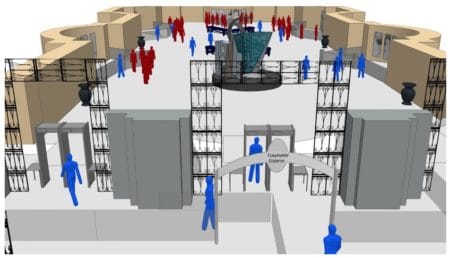THE WORLD AS WE KNOW IT IS CHANGING. The bottom line is that buildings are not going to be able to reopen and operate safely without robust post-pandemic planning for pedestrian movement. Real people get confused and break rules. It’s one thing to hang signs and tape lines and crosses to the floor but will people stay in their boxes and comply with the rules? Will they have a real fear of proximity? Knowing how to manage your space as guidelines ease, or if the government asks you to double down again overnight in the face of new waves of infection, is vital.
Designing with Social Distancing in Mind
It will come as a relief to learn that raw materials for greater certainty, and the flexibility to keep up with a dynamic situation over the months, and possibly years, are all readily available. The likes of 2D and 3D CAD drawings for your building can be used to render a 3D model of the building which can be populated with realistic, intelligent agents whose behavior is modeled by pedestrian movement software.
One example of technology that can be used to help map social distancing in a building is MassMotion, which is used by global consulting engineers and architects. It’s rather timely that the software world’s ubiquitous move towards subscription rather than outright licensing has come now, just as professionals across the built environment are grappling with the need to understand pedestrian behavior in more detail than ever before.

Pedestrian simulation software like MassMotion is now being used to model social distancing requirements in buildings.
MassMotion implements proximity modeling tests and visualizes scenarios within computer models. Its native 3D design means that crucial potential pinch points like stairs and elevators are also modeled accurately and can be observed in animated visualizations. Its sheer power means that new parameters can be entered into the model and a new simulation will run to test new ideas within minutes. Proximity modeling tools are used to show how close people are likely to get and for how long and highlight risk areas.
Oasys added proximity modeling to its pedestrian simulation software and explained: “What the team has done is to produce a new set of analytics that can be drawn from the software. We have also accelerated some experimental research to give customers the ability to test personal space preferences.”
Technology for Existing Buildings
Technology such as MassMotion will be crucial in designing and building future structures to ensure social distancing is far more achievable for the building’s occupants. But how can other technological solutions help support social distancing measures in pre-existing buildings? After all, spatial awareness cannot be accurately relied upon.
Currently, personnel distancing systems known as PDS are being trialed around the country. These proximity warning gadgets can be fastened to a person’s arm or belt, or in the case of construction sites, onto a hard hat. The technology can also be added to lanyards or wrist bands. Once the exclusion zone has been programmed, these tags will sound an alarm and vibrate if the wearer gets too close to another wearer.
The Future of Building Management
Understanding and optimizing how people use space is increasingly recognized by architects, but can it also inform smart environmental and energy management? As well as wearable smart sensors for people, there had been an innovation of smart sensors for buildings that detect the number of occupants in a space that would suggest that there is a growing overlap here.
Pedestrian movement analysis could be a long-term addition to our toolbox, not just an interim response to the pandemic.
About the Author
Amy Hodgetts is a content writer on behalf of Oasys, a leading commercial developer of engineering software. Ms. Hodgetts is a graduate from the University of Glasgow, with an undergraduate MA (Hons) in English Language
Key Resources
Interserve trials new social distancing warning technology on Birmingham hospital job
Technology to support social distancing in the new workplace




Reader Comments
Comments for this story are closed